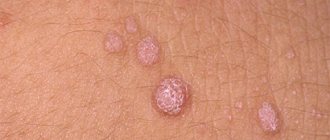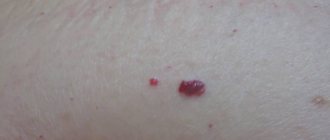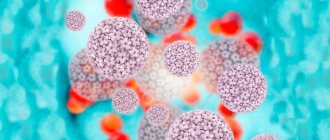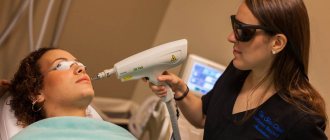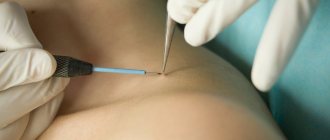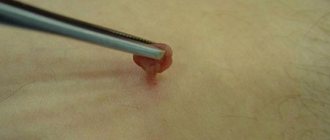Author of the article
Dmitry Savelyev
Practicing dermatovenerologist, graduated from the Russian National Research Medical University named after N.I. Pirogov.
Articles written
60
Papillomas are neoplasms of different texture, color and size.
Their appearance is caused by the action of the human papillomavirus. Similar growths appear on the skin and mucous membranes, including in the anus. At first, small-sized neoplasms appear, which subsequently increase the area of localization and grow into new associations. In the absence of adequate treatment, this conglomerate turns into a malignant tumor, indicating the onset of oncology.
Human papillomavirus
Viral infection
The papilloma virus from the Papovaviridea family has a tendency to infect epithelial cells and mucous membranes, transforming into an oncogenic nature. It happens that it settles in the vagina in women, in the urogenital tract in men.
Papilloma at the anus is a viral infectious disease with the formation of warts of a papillomatous nature on the mucous membrane and skin. Usually the virus lies dormant in the body, waiting for a special occasion. It begins to progress with a weakened immune system, if a person is experiencing severe psychological, physical stress or has undergone a course of chemotherapy or been treated with hormonal medications.
Condylomas in the anus are a chronic, recurrent form of HPV when the virus is activated. Usually it is benign in nature and does not have an oncogenic nature. But it causes particular discomfort to patients. If you ignore and do not remove papilloma in the anal area, then over time it can transform into a malignant form, highly oncogenic cancer of type 16, 18.
Alternative medicine
In some cases, you can get rid of papillomas in the anal area on your own. But at the same time, you need to understand that by refusing qualified help, a person exposes himself to great risk. After all, what he takes for a papilloma, in fact, may well turn out to be a malignant neoplasm. The consequences of such an attitude to the problem can be unpredictable and very sad.
Traditional medicine offers the following as therapy:
- oxolinic ointment;
- celandine;
- Yoda.
These products must be applied to the detected papillomas every day until the growths dry and disappear completely. It is necessary to take into account: in the absence of competent antiviral therapy, the risk of recurrence of tumors is extremely high. Typically, relapse occurs due to a weakening of the protective properties of the immune system.
There are several types of papillomaviruses
Anal neoplasms are divided into several types, taking into account the degree of carcinogenic danger and appearance:
Viral diseases
- Pointed in the form of growths with a thin base resembling ridges. Single or multiple settle, gradually merging with each other in a complex manner. At an early stage, when localized in the rectum, they are hidden, invisible to the naked eye, which poses difficulties for doctors when conducting diagnostics.
- Keratotic ones are similar in appearance to dense growths with a hard surface. They resemble tubercles or form a ring around the circumference of the anus, located in the form of single papules.
- Papules of a dark pink color, similar to warts in the anus. More often they form on the genitals and genitals in the form of a tumor-like swelling.
Varieties
| Classification | View | Peculiarities |
| By the nature of the manifestations | Single | 1 papilloma is formed near the perianal area |
| Multiple | Chaotic appearance or formation of several pathological formations nearby | |
| By appearance | Pointed | Growths on a thin stalk, colored pinkish |
| Tumor-like | Flat tumors that are rarely seen around the anus | |
| Papular | Formations colored dark pink and resembling a wart | |
| Grow inside the posterior opening and form a tubercle | ||
| Keratotic | New growths with a dry top layer |
The causative agent is human papillomavirus
New growth on the body
Anal papillomavirus is a microbial body with a microscopic form of life, but can only exist inside the cells of the human body. The causative agent of the virus is Papovaviridea. It settles in the cells of the mucous membranes or skin, causing papillomavirus infection.
Medicine knows over 91 varieties of this microorganism and several strains with low, medium, and high oncogenicity. Non-oncogenic strains – 12.41, settling on the soles in the form of warts. Weakly oncogenic - 6, 11, 30 strains, appearing as condylomas on the mucous membranes. Highly oncogenic strains - 16, 18, 39, 45, 56, 68 - are the most dangerous, developing on the skin and mucous membranes in the form of dysplastic changes, causing cancerous lesions.
The note! The most highly oncogenic is virus type 16, 18. It is often detected in women as cervical cancer.
The dangers of traditional medicine
Self-treatment leads to the degeneration of papillomas; before manipulation, it would not hurt to consult a specialist. Localization of neoplasms eliminates the possibility of self-medication.
It is possible to remove papillomas externally; this will not reduce the concentration of the virus in the body.
Among the recipes that have gained popularity:
- Iodine. There is no effectiveness, but there is a high risk of burns. The “advisers” reassure us that traces of the defeat will not be visible to anyone. No one mentions the long healing time and the risk of infection of the treated area.
- Laundry soap. The presence of alkali “guarantees” complete elimination of papillomas, but treatment is accompanied by damage to healthy tissue. It is recommended to apply a thick layer of soap to the anus and go to bed. Dubious advice, because the burning sensation of the alkali will not allow you to close your eyes.
- Saline solution. It is believed that salt dries out the thin stalk of the papilloma and it will disappear. You need to carry out daily procedures that require effort and a certain skill.
- Essential oils. The use is impractical, since the oil must be applied pointwise to a specific growth. It is difficult to cope with such a task on your own, so you will have to ask for help. If a person is not embarrassed to tell a loved one about the problem, then he will be able to trust the doctor.
- Onion and garlic. Compresses on anal papillomas will cause more discomfort and only increase the pain.
Doctors have a negative attitude towards such manipulations, since in pursuit of “cheap and fast” methods the patient misses valuable time.
Causes of genital warts
The main reason for the settlement of genital warts in the anus is infection with a viral infection if the pathogen penetrates deep into the body through cracks or microtraumas on the body.
Condylomas are benign growths. They can settle in almost any area, even in the anus. Then they begin to penetrate soft tissues and grow, increasing cancer rates. It happens that they merge and grow together, forming lumpy formations in the form of islands.
At first, benign neoplasms remain dormant. Only after a certain time they begin to flare up in the form of painful rashes in the anus, the reasons for which are:
Provoking factors
- promiscuity, when HPV is often detected in an infected person along with chlamydia, herpes, gonorrhea, syphilis;
- abuse of alcoholic beverages, narcotic drugs (cytostatics, immunosuppressants, glucocorticoids) that undermine the immune system;
- lack of personal hygiene;
- use of household items of an infected person;
- cold;
- bad habits (alcohol, smoking) that provoke activation of the virus;
- chronic internal diseases during exacerbations;
- prolonged stress;
- pregnancy;
- emotional stress with the appearance of characteristic rashes on the skin.
Anal genital warts can be located in the anus or rectum. If localization occurs in the walls of the colon in the form of a large growth, then constipation and fecal obstruction may occur. It is important to promptly identify and remove even minor changes in the epithelium in the anal area, otherwise the virus may spread to the genital organs: the vagina and uterus in women with the formation of a malignant tumor up to complete closure of the anus.
Risk factors
The main factor that activates the virus is weak immunity, but there are many other factors that can potentially cause the occurrence of papillomas in the anal area. Risk factors include:
- homosexual contacts;
- anal sex;
- casual sex;
- alcohol abuse and smoking;
- malnutrition, vitamin deficiency;
- chronic inflammatory processes;
- long courses of drug therapy;
- uncomfortable underwear;
- lack of intimate hygiene.
Traumatic skin areas are also a potential risk for the development of papillomas.
Route of transmission and conditions of infection
A common route of transmission of papillomavirus is sexual intercourse. The longer it is and the less protected it is, the more significantly the degree of HPV infection increases.
The skin in the anus is delicate and thin, easily injured. The virus begins to penetrate tissue through cracks and cuts.
The main routes of transmission of the virus:
Unprotected sexual contact
- sexual intercourse against the background of unprotected sexual intercourse;
- household in case of infection in public places with high humidity, transmission of the pathogen through non-sterile instruments during manipulation, because the microbe can live for some time in a humid environment;
- vertical from mother to newborn as the microbe moves through the placenta or during breastfeeding through milk;
- contact, when a child at birth becomes infected with HPV during passage through the birth canal.
Reference! People who are promiscuous, neglect personal protective equipment, and do not maintain personal hygiene of the external genitalia are at risk of contracting the HPV virus. Even modern methods of contraception do not guarantee complete protection against such infection. Infection can occur through direct contact, for example through household items and children's toys.
Condylomas in the anus
Condylomas around the anus
At first, condylomas in the anus look like pinkish papillae, then they can increase in size and merge with each other, forming a cauliflower. If they settle at the entrance to the anus, they can partially (completely) block the anus.
A special feature of condylomas located on the anus is the presence of legs and flesh-colored lobules. They are prone to rapid growth, proliferation, and increase in size. If they are localized in the perianal area, they begin to hurt.
Patients are considered carriers of HPV if the virus spreads to the groin, perineum, or anus.
Condylomas in the anal area symptoms
As the condyloma virus penetrates the outer layers of the epidermis, it first remains in an incubation period and does not manifest itself in any way.
If a shock occurs, the papillomavirus begins to rapidly multiply and become activated. Mature cells increase in size and move throughout the human body.
Signs in infected people completely depend on the location and size of the tumor:
- pain, difficulty defecating;
- burning, itching, pain, swelling in the anus;
- bleeding in case of injury to growths;
- the appearance of sexual and psychological discomfort;
- constant presence of a foreign body in the rectum;
- discharge of feces from the anus with an unpleasant odor;
- intoxication of the body;
- the formation of fistulas in the event of a secondary bacterial infection or suppuration of papillomas.
Reference!
Often condylomas in the anus affect the rectum. If caused by HIV infection or homosexual sexual intercourse, they can provoke blockage of the anus with the manifestation of recurrent symptoms. It happens that condylomas go away on their own for a while. They begin to assert themselves again as soon as the immune system fails. You can see what papillomas in the anus look like in a medical reference book or in a photo.
Externally, condyloma is similar to a common wart. It settles as a single small species or large (multiple), uniting and merging with each other. The main difference between condyloma and warts is the presence of a thin stalk and a rough top layer. As a rule, patients turn to doctors when growths in the anal area are already obvious and easily palpable.
Worth knowing! Signs of the virus on the body largely depend on the state of the immune system. The virus can decrease or increase in size and quantity at different periods of life. However, this infectious agent can only live inside the human body. It cannot live outside cells, although it retains its properties for some time, staying in the atmosphere in the fresh excretions of the patient’s feces.
Methods for diagnosing papillomas
Considering the location of papillomas and condylomas, the best solution is to consult a proctologist. He will determine the presence and type of growths, and will refer you for appropriate tests to establish an accurate diagnosis and subsequent treatment. Typically, for diagnosis, a person is referred to:
- general blood and urine analysis;
- “Colonoscopy” (an examination under general anesthesia in which a flexible tube with a video camera at the end is inserted into the colon);
- “Anoscopy” (insertion of a thin tube with a small light source into the intestine);
- “Sigmoidoscopy” (examination with an endoscope through the anus).
As you can see, the methods for examining the affected area are slightly similar to each other. Sometimes painkillers are used during these procedures. They allow you to examine the rectum with maximum accuracy. In rare cases, when there is a suspicion of oncology, during a colonoscopy the doctor may remove some rectal papillomas for further research.
If the presence of papillomavirus is confirmed, the most appropriate option would be to remove the growths and comprehensive treatment aimed at both fighting the virus and increasing immunity.
Anal condylomas diagnostics
First of all, when contacting a proctologist:
Carrying out the procedure
- conduct a visual inspection of the perianal area;
- examine the medical history;
- visually examine the growths around the circumference of the anus;
- determines the shade, shape (usually in the form of cauliflower);
- will redirect you to undergo a proctological examination to assess the condition of the muscles of the anus, epithelium of the anus and rectum.
Other diagnostic methods for recognizing condylomas in the anus:
- anoscopy with examination of the anus under a microscope to obtain a general assessment;
- sigmoidoscopy to examine the inside of the rectum up to 25 cm, starting from the anus;
- ELISA (PCR) to detect even minor changes in the epithelium of the anus.
To clarify the diagnosis, differential methods are prescribed to distinguish papillomas (condylomas) from squamous cell carcinoma, gonorrhea, syphilis:
- biopsy;
- Ultrasound;
- irrigography;
- Video rectoscopy of the anus.
Reference! In case of condyloma infection caused by sex, it is recommended that both sexual partners undergo diagnosis and treatment.
Prevention
Preventive measures include strengthening the immune system:
- you need to eat well;
- lead a healthy lifestyle;
- play sports and strengthen the body;
- eat enough fruits and vegetables;
- promptly treat all diseases, especially infectious ones;
- undergo an annual examination at the clinic.
Anal papillomas increase the risk of developing colorectal cancer. If characteristic signs appear, you must visit a proctologist and undergo the necessary tests to eliminate oncogenic risk.
Genital warts in the anal area
Growth in the anus
Genital warts look like small genital warts with jagged, cauliflower-like edges. More often these are oncogenic strains of the virus type 16-18.
They are localized in women on the genitals, labia, causing damage to the cervix and vagina. In men - on the skin of the foreskin, glans penis, leading to damage to the urethra, bladder, and skin around the anus.
Reference! The virus becomes extremely dangerous and can develop into cancer if it stays in the body for more than 1 year. Usually invisible, it begins to appear at the last stage of infection, when treatment becomes difficult and sometimes pointless.
In men, genital warts settle extremely rarely in the anus, on the head or frenulum of the penis. Although they are no less dangerous, they require urgent removal, and it is impossible for patients with them to have a normal sex life or observe normal personal hygiene measures.
Reasons for appearance
The main cause of anal papillomas is the activation of the papillomavirus. HPV can be present in the body in latent form for a long time and manifest itself after infection months or years later. Most often, the causative agents of these growths are the 6th and 11th strains of the virus. In this case, neoplasms can be simultaneously observed on the genitals: in the vagina, on the labia, shaft of the penis or foreskin.
Papillomas appear when natural immunity weakens and HPV begins to actively multiply. This may be caused by:
- experienced stress;
- exacerbation of chronic diseases;
- pregnancy period;
- frequent overwork;
- changes in hormonal levels;
- bad habits.
All these factors reduce the body’s defense reactions, as a result of which the virus is activated. At the same time, several types of HPV may be present in the body at once, which complicates the treatment process.
Course of the disease
The HPV virus is resistant to heat treatment. Can live in the external environment for some time. It multiplies quite slowly and is not detected in the blood. This is an etiotropic pathogen that can lead to layer-by-layer damage to the epithelium of the mucous membrane or skin.
Several types of papillomavirus can be detected in one patient. The main route of transmission of the virus is an infectious agent that transforms the basal cells of the epidermis, which begin to divide, forming condylomas or papillary polyps on any part of the body. In advanced cases, condylomas occupy significant areas of the anal area and spread to nearby healthy areas. It happens that the condyloma virus subsides and even disappears for a certain time. However, it remains in the body and can be quickly activated if the immune system is weakened.
If condylomas are not removed in a timely manner, they will gradually begin to increase in number and occupy large areas. The risk of infecting a sexual partner will increase significantly.
Important! Medical help from doctors should be sought urgently if condylomas bleed, lead to difficulties in anal hygiene and psychological discomfort.
Features of the infection process
Usually one of the partners has anal papillomas, and the same manifestations soon await the other. True, in some situations everything happens differently. One person has growths on the anus and after removal they recur, but his partner does not have them throughout his life. How to explain this phenomenon? In fact, the reason lies in the abilities of the immune system: with weak protection, papillomas are difficult to treat and often recur, and with strong protection, a person can remain only a carrier of the virus for the rest of his life. In this case, HPV can only be detected using a blood test.
As for sexual transmission, it can occur even with the use of a condom. After all, any contact of a patient with the mucous membranes and skin of a healthy person, subject to even the slightest damage, contributes to the entry of HPV into the body.
Papillomas of the anal canal, when infected through household contact, can occur if all family members use one common towel.
During childbirth, the baby easily picks up the virus as it passes through the birth canal. That is why doctors recommend getting rid of the problem even before pregnancy.
Complications of perianal condylomas
Perianal condylomas, if they grow, can block the lumen of the anus, since they are prone to recurrence and re-development even after initial successful removal.
Some types of condylomas degenerate into cancerous tumors, although usually they do not have high oncogenicity when they settle in the anus. The main thing is to remove it in a timely manner or treat it with medications so that it does not form into a malignant tumor, subsequently spread to the genitals, acquire a purulent infection, or develop sepsis.
Treatment of condylomas in the anal area
Treatment measures
If condylomas are detected in the anus, doctors usually resort to surgery or cauterization. The method of cryotherapy and electrocoagulation with excision of a piece of affected tissue, followed by histological examination, is widely used to exclude (confirm) degeneration into oncology. Condylomas are excised together with adjacent healthy tissue.
If flat condylomas are detected in women on the mucous membrane of the vagina or cervix, then an additional biopsy is performed with a piece of tissue taken for analysis. If the degeneration of cells into a cancerous tumor is confirmed, then radical surgery is performed. Sometimes, in case of dysplasia of the affected tissue, extirpation is performed.
Surgical methods for removing papilloma:
- laser - a bloodless, non-contact option for removing anal condylomas with a laser, leaving a crust at the site of condyloma removal, although the likelihood of scarring and relapse remains high;
- radio wave by applying a radio wave electrode to the tumor for cutting, followed by coagulation of blood vessels, applying an antiseptic bandage;
- surgical performed under local anesthesia.
If cell dysplasia is not observed, then drug therapy is prescribed according to a specific regimen including antiviral agents:
Medicine
- Viferon (suppositories, gel) - a modulator of the immune response for condylomas in the anus;
- Genferon from the group of interferons with the introduction of rectal suppositories into the anus;
- Allokin-alpha for suspected transformation of condyloma into a malignant tumor;
- Lykopid is an immunomodulator to stimulate the functions of the immune system;
- Epigen intimate with local use to relieve swelling and itching, heal wounds, strengthen local immunity.
Treating papillomas with folk remedies (especially when found on the genitals of women) is strictly prohibited. Although many patients try to resort to folk remedies when they see a wart on the body.
Important! It is folk remedies that, instead of the expected benefits, can provoke an outbreak and progression of the papilloma virus. Removal of the genitals in women should be carried out only in a hospital setting and with subsequent collection of material for testing for dysplasia.
An effective method of getting rid of genital warts is cryocoagulation (cauterization with liquid nitrogen), a painful procedure. In 80% of patients, after 2-3 sessions, complete elimination of condylomas is observed. With the permission of a doctor, it is possible to use celandine juice in acceptable doses with application to genital warts after preliminary steaming of the skin and subsequent smearing of the affected area with a greasy cream. You can also use plantain juice, treating the growths 2-3 times a day.
Treatment
It is quite rare that HPV can be completely cured. But it is possible to stop the reproduction of formations and their further development. First of all, it is necessary to remove the growths. The following methods are used for this:
- Laser removal.
- Radio wave therapy.
- Method using electric current.
- Surgical intervention.
To avoid relapses and minimize the development of HPV, the patient is also prescribed antiviral drugs, immunomodulators and a complex of vitamins.
Treatment should be carried out strictly according to the doctor’s recommendations. You should not use traditional medicine. Medicinal decoctions and tinctures are not able to suppress the virus. During treatment, the growths may disappear, but since the virus itself has not been destroyed, there remains a high probability that the growths will appear again.
Gay syndrome
Gay syndrome is observed in homosexuals in cases of condylomas affecting the walls of the colon. Gay and bisexual men are recommended to receive the vaccine, since sexually active people are more likely to become infected with HIV infection or HPV types 16, 18. A sexually active person can become infected with the virus even after only having sex with an infected partner. Treatment is carried out taking into account the individual characteristics of patients.
The main thing is to undergo a course of therapy in a timely manner to prevent the development of anal fissure and gonorrhea.
Forecast
Unfortunately, it is impossible to completely cure the papilloma virus. If primary infection occurs, the person remains a carrier for his entire life. The prognosis is favorable if papillomas are removed in time and their activity is significantly reduced. Doctors often manage to suppress the activation of condylomas in the anus in one session.
To achieve treatment effect, it is important for patients to:
What does official medicine say?
- treat concomitant sexually transmitted diseases;
- use condoms;
- have a permanent partner;
- keep a healthy sex life under control;
- take courses of strengthening tonics;
- harden the body;
- take Interferon against many surrounding viral invaders.
HPV infection - latent begins to progress only with reduced immunity, outbreaks of chronic diseases, alcohol and tobacco abuse. Unfortunately, the virus remains in the human body even after removal of condylomas from the body.
Even after the initial removal of condylomas, patients are under constant medical supervision for another 1 year. Women are tested and examined by a gynecologist, men by a urologist. It is the provoking factors that allow the virus to activate. Preventing its development means avoiding stress, treating acute and chronic diseases in a timely manner, eliminating stress on the body and prolonged exposure to alcohol.
Removal methods
Methods for cleansing the skin and mucous membrane depend on the size of the processes, their shape and location in the intimate area. Common ways are:
- Cryodestruction, during which tissues are cooled to extremely low temperatures with liquid nitrogen. Freezing destroys the vital activity of cells, the growth is eliminated, and healthy skin is formed in its place.
- Electrocoagulation carried out using electric current. Under its influence, the papilloma is cauterized. This method is not used to eliminate growths inside the rectum.
- Laser removal, which heats the affected area with a powerful stream of light. As a result of highly focused radiation, pathogenic skin cells are destroyed.
In addition to these methods, the doctor may suggest standard surgical removal and burning of papillomas with Podophyllin solution. Before any intervention, a thorough examination is necessary. Tissue healing occurs over several weeks. After surgery, women need to be observed by a gynecologist to prevent the formation of papillomas in the vagina. Men should undergo additional tests and urethral swabs.
If growths bother you during pregnancy, you need gentle treatment that does not involve exposure to powerful medications. You can use traditional methods or perform laser removal. Treatment tactics should only be determined by a specialist.
It is impossible to completely get rid of papillomavirus. The operation removes external signs of the disease. To prevent them from appearing again, you need to take care of your health and take medications that boost your immunity every six months.


